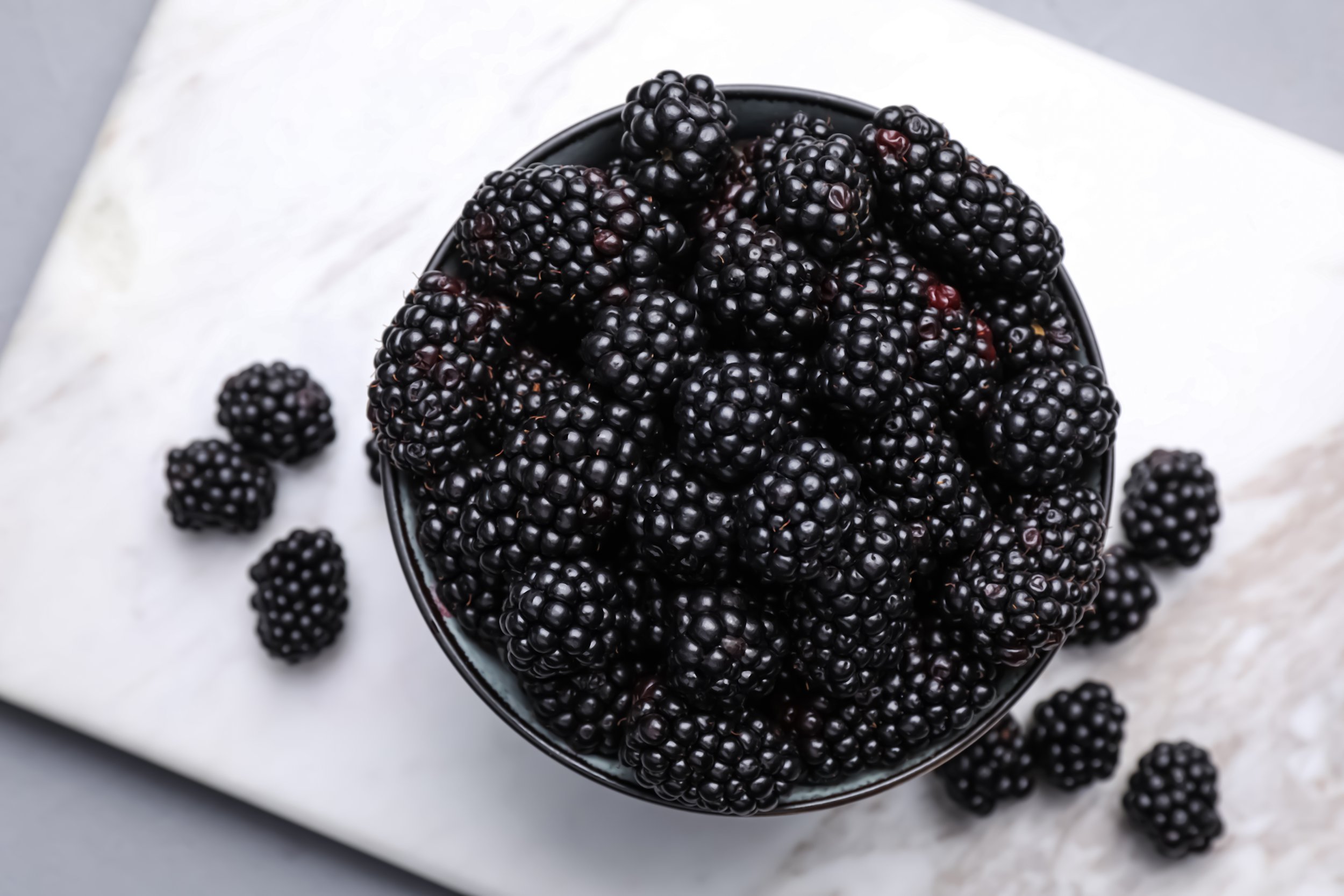Berries and Buckwheat
by Sidonie Maroon , The Food Co-op Culinary Educator, abluedotkitchen.com
Follow Sidonie on The Food Co-op’s Facebook group Cooking with the Co-op
Berries and Buckwheat
A yogurt container hangs around my neck by a cord, leaving my hands free to pick blackberries from the hedge that surrounds my friend’s garden. Her Himalayan blackberries are ripe, and while not as tasty as a Marionberry, they are prolific.
A Berry Wealthy Woman
If given the choice between status, wealth and berry picking, I’d choose the berries. It’s one of my favorite activities. Please, give me mornings of blueberries; combing their clusters through my fingers—a quiet row of raspberries at sunset, or wandering on trails while stopping to eat thimbleberries, and later the ripe blackberries.
When I returned home with my bounty of blackberries, I wondered how a blackberry crumble would taste using buckwheat groats? Hmm—with pecans, sunflower seeds, cinnamon, dates…. It’s looking yummy.
Introducing Buckwheat
Buckwheat (Fagopyrum esculentum) is native to south central China and Tibet, and it isn’t a grain at all but a pseudo-cereal related to sorrel and rhubarb. It’s grown for its grain-like seeds with red stems and pink and white flowers. The bees love it and it does well in our climate.
It’s a short season crop with only a ten to twelve week season, so it grows quickly, and in low fertility soils blooming in cool weather. It’s often used as a cover crop and as a green manure in between planting cycles of other plants.
Before the use of nitrogen fertilizers in the 20th century, growing buckwheat was common in the northeastern United States and we harvested over 1,000,000 acres in 1918, but by 1964 we grew only 50,000 acres. Although, as farmers and cooks realize how sustainable and nutritious buckwheat is, a comeback is in the works.
Buckwheat Cuisines
Perhaps you’re familiar with the dark buckwheat flour used for American pancakes and French crepes, or the toasted buckwheat groats known as kasha used in Eastern European and Jewish dishes, or the milder groat flour used as the basis of noodles in Korean and Japanese cuisines?
Why I Like Raw Buckwheat Groats
While I like the dark buckwheat flour for the occasional pancake or crepe, I go through a 25 lb bag of hulled buckwheat groats every 3 months. It’s easy to cook with and has a mild sweet flavor that goes with so many dishes and cuisines. I grind it in my Vitamix as a part of my flour-on-demand mixes, use it as a pilaf like rice, make porridge, use it in salads, soups and casseroles. Compared to white rice, white flour or corn, it’s superior and tasty.
Bonus!
Buckwheat is a rich source of protein, fiber, B vitamins, niacin, magnesium, manganese, phosphorus, phytochemicals, and is gluten-free for those with gluten related disorders.
The Correct Way to Cook Buckwheat Groats—unless you prefer MUSH.
I discovered how to cook buckwheat groats so they’re firm, and more like perfect rice, than mushy polenta. Now I frequently use them as a base for salads, pilafs and casseroles. The trick is to decrease the water to groat ratio (1 part buckwheat to 2 parts water), cook them for a shorter time (10 minutes at a simmer), and allow them to sit off the heat and continue to plump (20 minutes with the lid on off the heat.)
Berries and Buckwheat Breakfast Bake
Makes one 13 x 9 x 2 oblong casserole
For Buckwheat
1 cup dry hulled buckwheat groats (not toasted kashi)
½ teaspoon sea salt
2 cups water
Pear and Blueberry Buckwheat Breakfast Bake
Makes one 13 x 9 x 2 oblong casserole
Ingredients
For Buckwheat
1 cup dry hulled buckwheat groats (not toasted kashi)
½ teaspoon sea salt
2 cups water
For Crumble
2 cups pecans
½ cup hulled raw sunflower seeds
¼ cup ground flaxseeds
1 tablespoon ground cinnamon
¼ teaspoon sea salt
1 cup pitted deglet dates, chopped
For Fruit
3 cups chopped pears
3 cups fresh or frozen blueberries
¼ cup tapioca flour
1 tablespoon vanilla extract
1 ½ teaspoons liquid monk fruit, or sweetener of choice (for cane sugar, use 2 tablespoons per cup of fruit= ¾ cup)
Directions
1. Line the casserole with parchment paper. I scrunch the parchment into a wad and unfold it, so that it’s easy to fit into the shape.
2. In a small saucepan, bring 2 cups of water to a boil, add 1 cup buckwheat groats and ½ teaspoon salt, cover with a lid and reduce the heat to a simmer. Cook for 10 minutes. Turn the heat off and let stand with the lid on for 20 minutes. Drain the cooked groats in a colander.
3. While the buckwheat is cooking: grind the flax in a spice grinder. Using a food processor— pulse the pecans, sunflower seeds, cinnamon, salt and ground flax together. Make small pieces, but not a paste, so try 5 to 6 pulses. Pulse the chopped dates separately in the same way.
4. In a work bowl, mix the blueberries, pears, sweetener of choice, vanilla and tapioca together.
5. Divide the buckwheat into two bowls. Mix half of the nut and seed crumble mixture into each bowl and all the dates into one.
6. Press the mixture with the nuts, seeds and dates into the bottom of the prepared casserole. Add the fruit to the middle, and top with the seed, nut and buckwheat mixture.
7. Bake in a preheated 375℉ oven for 40 minutes. If you want the casserole sweeter, or to have a baked sugar top — sprinkle on a handful of brown sugar during the last 10 minutes of baking.
Serve warm, or allow to cool. I think the casserole gets better as the flavors develop. We warm individual slices, or eat them cold.
Apple and Plum Buckwheat Breakfast Bake
Makes one 13 x 9 x 2 oblong casserole
Ingredients
For Buckwheat
1 cup dry hulled buckwheat groats (not toasted kashi)
½ teaspoon sea salt
2 cups water
For Crumble
2 cups walnuts
½ cup hulled raw sunflower seeds
¼ cup ground flaxseeds
1 tablespoon ground cinnamon
¼ teaspoon sea salt
1 cup pitted deglet dates, chopped
For Fruit
3 cups chopped tart baking apples
3 cups chopped plums of choice
¼ cup tapioca flour, or instant tapioca
1 tablespoon vanilla extract
1 ½ teaspoons liquid monk fruit, or sweetener of choice (for cane sugar, use 2 tablespoons per cup of fruit= ¾ cup)
Directions
1. Line the casserole with parchment paper. I scrunch the parchment into a wad and unfold it, so that it’s easy to fit into the shape.
2. In a small saucepan, bring 2 cups of water to a boil, add 1 cup buckwheat groats and ½ teaspoon salt, cover with a lid and reduce the heat to a simmer. Cook for 10 minutes. Turn the heat off and let stand with the lid on for 20 minutes. Drain the cooked groats in a colander.
3. While the buckwheat is cooking: grind the flax in a spice grinder. Using a food processor— pulse the walnuts, sunflower seeds, cinnamon, salt and ground flax together. Make small pieces, but not a paste, so try 5 to 6 pulses. Pulse the chopped dates separately in the same way.
4. In a work bowl, mix the apples, plums, sweetener of choice, vanilla and tapioca together.
5. Divide the buckwheat into two bowls. Mix half of the nut and seed crumble mixture into each bowl and all the dates into one.
6. Press the mixture with the nuts, seeds and dates into the bottom of the prepared casserole. Add the fruit to the middle, and top with the seed, nut and buckwheat mixture.
7. Bake in a preheated 375℉ oven for 40 minutes. If you want the casserole sweeter, or to have a baked sugar top — sprinkle on a handful of brown sugar during the last 10 minutes of baking.
Serve warm, or allow to cool. I think the casserole gets better as the flavors develop. We warm individual slices, or eat them cold.
Peaches and Blueberry Buckwheat Breakfast Bake
Makes one 13 x 9 x 2 oblong casserole
Ingredients
For Buckwheat
1 cup dry hulled buckwheat groats (not toasted kashi)
½ teaspoon sea salt
2 cups water
For Crumble
2 cups almonds
½ cup hulled raw sunflower seeds
¼ cup ground flaxseeds
1 tablespoon ground cinnamon
¼ teaspoon sea salt
1 cup pitted deglet dates, chopped
For Fruit
3 cups fresh or frozen blueberries
3 cups fresh or frozen diced peaches
¼ cup tapioca flour, or instant tapioca
1 tablespoon vanilla extract
1 ½ teaspoons liquid monk fruit, or sweetener of choice (for cane sugar, use 2 tablespoons per cup of fruit = ¾ cup)
Directions
1. Line the casserole with parchment paper. I scrunch the parchment into a wad and unfold it, so that it’s easy to fit into the shape.
2. In a small saucepan, bring 2 cups of water to a boil, add 1 cup buckwheat groats and ½ teaspoon salt, cover with a lid and reduce the heat to a simmer. Cook for 10 minutes. Turn the heat off and let stand with the lid on for 20 minutes. Drain the cooked groats in a colander.
3. While the buckwheat is cooking: grind the flax in a spice grinder. Using a food processor— pulse the almonds, sunflower seeds, cinnamon, salt and ground flax together. Make small pieces, but not a paste, so try 5 to 6 pulses. Pulse the chopped dates separately in the same way.
4. In a work bowl, mix the blueberries, peaches, sweetener of choice, vanilla and tapioca together.
5. Divide the buckwheat into two bowls. Mix half of the nut and seed crumble mixture into each bowl and all the dates into one.
6. Press the mixture with the nuts, seeds and dates into the bottom of the prepared casserole. Add the fruit to the middle, and top with the seed, nut and buckwheat mixture.
7. Bake in a preheated 375℉ oven for 40 minutes. If you want the casserole sweeter, or to have a baked sugar top — sprinkle on a handful of brown sugar during the last 10 minutes of baking.
Serve warm, or allow to cool. I think the casserole gets better as the flavors develop. We warm individual slices, or eat them cold.







